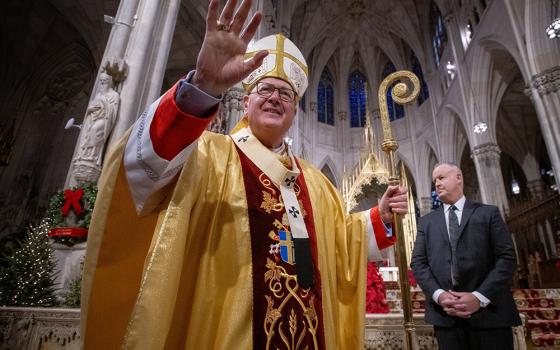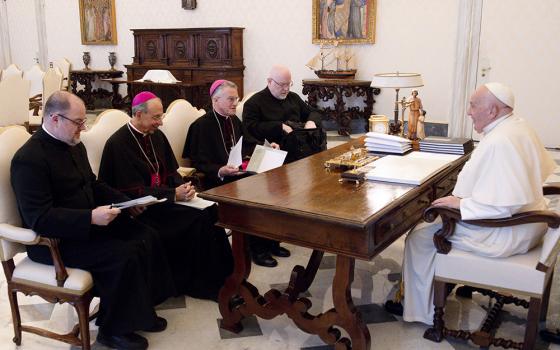A stained glass image of Jesus the Good Shepherd is pictured at Jesus the Divine Word Church May 6, 2021, in Huntingtown, Maryland. (CNS /Bob Roller)
In 2012, National Geographic published a story about a papyrus fragment containing a reference to the wife of Jesus Christ. The fragment was later declared fraudulent, but Sue Monk Kidd had started thinking about the possibility of Jesus having a wife. Who would she be? What would she look like? How would she think and feel?
Kidd decided her name would be Ana. She would speak four languages, be a talented writer and come from a wealthy Jewish family, have long black frizzy hair and large dark eyes similar to a face that Kidd had seen on a mosaic known as the Mona Lisa of Galilee. She would have a brilliant aunt, a controlling mother, a money hungry father who walked with a limp and a brother, Judas, who was a Zealot.

Soon, Kidd asked herself what happened to Jesus in the years not covered in the canonical Gospels. D.H. Lawrence, Norman Mailer, Nikos Kazantzakis and others had already explored similar questions with Kazantzakis' novel, The Last Temptation of Christ, arguably the most popular take among the group. Kazantzakis' story came out in Greek and then in English in the 1950s and was promptly put on the list of forbidden books.
Now, in her fourth novel, The Book of Longings, Kidd also embellishes the Gospel story of Christ. But her book, just out in paperback, should not scandalize most readers. Nor has it been banned by the Catholic Church.
Kidd says people will never know whether Jesus was celibate. But it's quite possible that he was married since during Jesus' time, Jewish men were expected to marry and procreate. If they did not marry, it was humiliating for their parents.
Hoping to better understand the life of the single most important individual in history, Kidd spent approximately five years researching daily existence among Jews living in the Galilean world of the first century.
With her research as background, Kidd invents the years between Jesus being lost in the temple and the start of his public ministry, years when no one knows what happened to Jesus except that, as Luke puts it, he grew in wisdom, age and grace (2:52). During this time, as Kidd sees it, Jesus marries Ana. He has sex with her, but Kidd handles this with deft strokes with Ana modestly saying, "I knew my husband, and he knew me."
Advertisement
A Christian, Kidd has a sense of feminine spirituality. She doesn't quite explain this nebulous term, but she seems to mean feelings of connectedness to nature, interest in archetypes, the ability to interpret dreams and an intuitive sensibility. Her bestselling third novel, The Secret Life of Bees, emphasized the feminine nature of the divine as seen through the spiritual influence of the statue of the Black Madonna.
Carl Jung and Trappist Fr. Thomas Merton inspired Kidd. Jungian concepts are prevalent in Kidd's work. Merton's influence is evident but not as much. This fourth novel relies on Jungian dream theories with two of the three main characters, Ana and her Aunt Yaltha, having predictive dreams and almost a sixth sense when it comes to an awareness of trouble.
Kidd avoids most of the egregious aspects of other Jesus novels by making Ana the protagonist and using the first person point of view. So this is Ana's novel — not Jesus'. It looks at Jesus through Ana's perspective. The story includes only what Ana sees or hears about.
It begins as Ana is 14 and is repulsed by the wealthy widower her father has chosen to be her husband. Then she meets Jesus at the marketplace. He is about 20, and Ana is immediately attracted. Adding suspense, readers don't know what Jesus thinks about Ana until much later.
When they talk, Ana learns that Jesus already has a sense of being called by God for greater things. This makes him even more attractive to her. She also has a longing for the divine, primarily for Sophia (or Wisdom), considered the feminine side of God.
Ana has several longings (as in the title). She especially longs to educate herself. She hopes to be a scribe and to write books (codicils) about the women of the Old Testament. She insists that, like her, these women are given short shrift in the patriarchal world.
A previously unknown scrap of ancient papyrus written in ancient Coptic is pictured in this undated handout photo. (CNS/Courtesy Harvard University/Karen L. King)
Jesus understands her yearnings and supports her decisions even regarding her practice of birth control, which is frowned on. He isn't so much a miracle worker as he is a good person who wants to help the poor and the outcasts. He disdains materialism and hypocrisy; he dislikes Jewish purity laws; and he advises people to trust in God — to be, as he says, several times in this novel, like the lilies of the field.
Jesus is a kindly young man with broad cheekbones, expressive eyes and a long nose. He, as a devout Jew, wears Tzitzit (blue tassels on his clothing) reads the scriptures and feels connected to God especially since his own father, Joseph died.
Jesus works as a carpenter, fisherman and stonemason. When he learns about the preaching of John the Immerser (the Baptist), he takes time off from work to follow this man and leaves Ana behind in the family home.
After John the Immerser's death, Jesus takes up the charge of bringing news of God's kingdom to the Jews. Ana worries about him, especially when she thinks her brother has betrayed Jesus — all of which suggests the power of the dramatic irony that encapsulates this narrative and draws readers into a story where they know what will happen to Jesus, but they don't know how or why. Ana stays with Jesus as he dies on the cross and is devastated. There is no Easter Sunday, or at least she doesn't witness one.
This is Ana's novel — not Jesus'. It looks at Jesus through Ana's perspective. The story includes only what Ana sees or hears about.
Kidd's Ana lives in a world that squelches women. Jewish laws dictate every aspect of her life. Even she, as the daughter of Matthias, the chief scribe of Herod Antipas, and later as a brilliant writer, is not given the respect she deserves.
Ultimately, Ana is a survivor; she is shrewd and feisty — unlike her husband. She tells Herod's wife that she is no lamb, an obvious allusion to Jesus being the Lamb of God. She's an individualist and curses the renowned rabbi, Ben Sira. Like many aspects of Kidd's narrative, the reference to the rabbi is true. A Hellenistic Jewish scribe, sage and allegorist, Ben Sira was the author of Sirach — the Book of Ecclesiasticus.
His words, Ana observes with irony, "flapped through the synagogues of Galilee as if borne by angels. 'The birth of a daughter is a loss. Better is the wickedness of a man than a woman who does good.' "
One of the pleasures of reading this novel is in noticing its many factual allusions from descriptions of life in Sepphoris, the wealthy town where Ana lives with her family; to her years living in the poverty-stricken town of Nazareth with Jesus and his family; to her months living with her wealthy uncle in Alexandria and visiting its immense library; and, as the book ends, to her life in the commune of Therapeutae, an actual monastic-like community near Lake Mareotis in Egypt. Here she studies and writes her numerous books, which ironically includes this engaging, memoir-like novel that she calls her testament.
And so it is.







